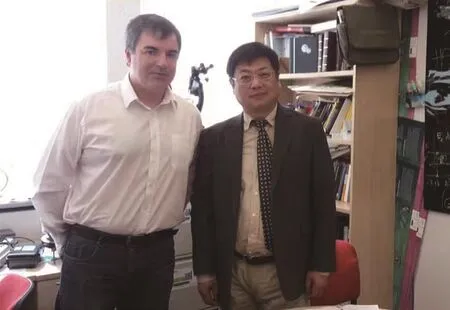Nobel Prize Winner Konstantin Novoselov:Like Graphene, the Softer, the Stronger
2019-07-16WrittenbyXiaoXiaoTranslatebyCarmenZhang
Written by Xiao Xiao / Translate by Carmen Zhang
If one day, mobile phones and cameras can be bendable and foldable, and they are not taken as something stiff in our pockets or carried as a burden on our shoulders anymore;
If one day, new energy vehicles no longer need to be recharged every night for the next day’s commute or for long-distance journeys, and we would never be embarrassed and troubled by lack of power;
If one day, electronic devices become wearable, drugs can be delivered directly to the injured body parts without oral intake,and people in the less developed regions can get access to cleaner water, our lives will become more and more secure and comfortable.
If this day really comes, it will be attributed to the emergence of this thing.
Thin and Light, yet Strong
In the magic nature, there is a common element that exists in many forms both in the atmosphere and in the Earth’s crust. It has long been identi fied and utilized, and a series of compounds synthesized from it - the organics - form the basis of life. For example, it is one of the components of pig iron, wrought iron and steel. Through chemical self-bonding, it can form a large number of compounds. Meanwhile, most molecules in organisms contain such elements.
This element is called carbon.
The allotrope of elemental carbon is called graphite, which is the softest mineral. It is most widely used to manufacture of things such as pencil leads and lubricants.
When it comes to graphite, we may think of a popular new material - graphene.
So, what is the relationship between graphite and graphene?
To put it in a simple way, graphite is composed of layers of graphene. For example, a 1 mm graphite flake contains approximately 3 million layers of graphene.
How was such a thin, unimaginable and indescribable material discovered?
In 2004, two scientists from the University of Manchester, Andre
Geim and Konstantin Novoselov, found out a fairly simple way to get thinner and thinner graphite fl akes. They stripped graphite fl akes from highly oriented pyrolytic graphite (HOPG),stuck the two sides of a fl ake to a special type of adhesive tape.By peeling the adhesive tape, the graphite fl ake was split into two pieces. They repeated such process and the graphite fl akes they got became thinner and thinner. Finally, they got a fl ake consisting of only one layer of carbon atoms. This is graphene.In 2009, Andre Geim and Konstantin Novoselov discovered the Integer Quantum Hall Effect and the Quantum Hall Effect at room temperature in the single-layer and double-layer graphene systems respectively, for which they won the Nobel Prize in Physics in 2010. Prior to the discovery of graphene,most physicists still believed that the effect of thermal fl uctuations did not allow the existence of any two-dimensional crystal lattice at finite temperatures. Therefore, such discovery immediately shocked the condensed matter physics community.Graphene is one million times thinner than a human hair, yet 200 times stronger than steel. By far, it is a new nano material that is the thinnest and strongest, with the best electrical and thermal conductivity. Therefore, it is called the “black gold”.
Always trying to do something new
In January 2019, with the help of Dr. Zhang Qijun, president of the Overseas Chinese Society for Technology & Business in UK,I got the chance to interview Konstantin Novoselov, one of the discoverers of graphene and one of the winners of Nobel Prize in Physics in 2010.
Konstantin was born in a small town in the Ural Mountains of Russia, where his mother has been living. He went to the university in Moscow, and studied for a Master degree in the Netherlands. Finally, he followed his mentor and came to the University of Manchester. In the eyes of his friends, he is a “workaholic” as he often stays in the lab till late. I think it is with his dedication and commitment that he made great achievements in research.
“Yes, I have a wealth of knowledge about physics and nanotechnology. But even if you know physics very well, there is no guarantee that you will make innovative breakthroughs.Then what can spark off new ideas? This is a very good question. But I can't tell you speci fically how to come up with innovative ideas. The only thing I know is that you need to work hard and keep trying new things so that you can discover something new.” Konstantin said.

Professor Kostya Novoselov and Dr. Zhang Qijun
As head of the British International Talents and Innovation Development Service Center, an overseas expert organization of the State Administration of Foreign Experts Affairs, P. R.of China, Zhang Qijun has invited foreign experts including Konstantin to participate in China's scienti fic and technological exchange activities for many times. Through Dr. Zhang Qijun,I learned that Konstantin's wife is also a researcher, and they fell in love in the lab. His wife Irina currently works as a project director in a biotech company in Manchester. They have twin daughters, Victoria and So fia.
As a scientist couple, Konstantin and Irina attach greater importance to their children's education and the cultivation of their children's scientific spirit. Konstantin believes that it is important to provide their children with a certain degree of freedom. Pushing children into a field that they are reluctant to explore would be completely counterproductive. Therefore, it is important to identify the passion of your children, let them follow their heart, and head towards that direction. It doesn't matter which direction they choose, as long as it can lead to success.
Science is esoteric to the public. But if you really love it and devote yourself to it, you might share the same feeling as Konstantin. “I think science itself is very exciting. Once you get started and have a try, you’ll get very excited about it. It’s also fun to solve problems and predict what will happen next with some basic skills and techniques. As long as we can demonstrate the relevance of such knowledge in real life, I think any child will be interested in science.”
I hope that science can be supported as much as technology.
In January 2019, Dr. Zhang Qijun accompanied Konstantin to China to attend a symposium of foreign experts organized by the Ministry of Science and Technology. Konstantin gave a wonderful speech at the symposium, and was cordially received by Premier Li Keqiang. In his speech, he highlighted the importance of materials in human production activities and daily life. He said that materials have always been a decisive factor for the technology. We even name different historical periods after the dominant material being used at that time:Stone Age, Bronze Age, Iron Age, and etc.
Indeed, new technologies promote the development of new materials, and new materials in turn boost the development of new technologies. Materials have changed our lives, while our lives are increasingly dependent on new materials. Konstantin believes that there will be more design materials or materials on demand,which can be called “smart materials”. These smart materials can bring more opportunities to manufacturing. They can adapt to the changes in the environment and fine tune their features to achieve the best possible performance. He said: “Just imagine, if the windscreen of a car can gather energy from vibration, illumination or rain and then use the energy to heat itself up so as to remove mist...” How ef ficient and convenient our life will be.
With the help of Dr. Zhang Qijun, Konstantin is currently looking for a partner in China, because he has great expectations for the development of China’s advanced materials. He said that manufacturing sector in China has been growing rapidly in terms of its scale and complexity. A growing number of advanced technologies have been adopted in manufacturing. Advanced technologies always go hand to hand with the developments of the advanced materials, and China managed to develop and adopt a large number of advanced materials. He believes that two things contribute to the rapid development of China’s advanced materials: investment in large scale manufacturing and investment in start-ups. However,the ef ficiency of investment still needs to be further improved.Moreover, most of that material development was not initiated by China. Often times, Chinese researchers and engineers are following suit rather than coming up with their original work.Most of the investment has been going towards the research institutes and companies with the universities being underinvested. So many researchers are reluctant to pay much attention to the fundamental research.
“Of course, I think the Chinese government has been doing a good job, as it provides many incentives for creating new businesses and developing new growth engines so that companies are not afraid to create new ideas and new products outside that are not available in the market. At the same time,the government is working hard to encourage and promote more high-tech products. That's why China has made great progress in scienti fic research. But if the government can give as much support in science as in technology, China’s scienti fic research will achieve greater success.”
How far will graphene go?

Professor Kostya Novoselov's family are enjoying tea in Dr. Zhang Qijun's home
Known as “black gold”, graphene is the thinnest and strongest new nano material with the best electrical and thermal conductivity by far. It is also one of the most promising advanced materials in the future. In recent years, Chinese government has rolled out a series of policies and related standards to support the development of the graphene industry.According to the roadmap for industrial development, the overall target for graphene industry in the future is de fined as follows: to form an industrial scale of 10 billion yuan by 2020,and accomplish the strategic goal of an overall industrial scale of 100 billion yuan in 2025.
Because of its excellent high temperature resistance, electrical conductivity, thermal conductivity, lubricity, chemical stability,plasticity, and thermal shock resistance, graphene is widely used in production and daily life. For example, it has been applied in various fields, namely, transparent conductive electrodes, touch screens, solar cells, lithium batteries, super capacitors, thermal films, seawater desalination, environmental pollution control and heath care.
In this regard, as a scientist, Konstantin is more forwardlooking than most of us. He said: “Graphene has the potential to be used in many different fields. We don’t usually discuss graphene alone. Instead, we discuss the two-dimensional family, a member of which is atomic materials. Graphene also belongs to this family. We put them together for discussion to extend the scope and field of their application.” He thinks that the research on graphene and its industry are very promising.Graphene has not only been well utilized, but also developed very fast. But except the world-renowned companies, some companies still need to improve the quality of their products.Therefore, he expects and firmly believes that more high-tech companies will manufacture high-quality products.
Light-weighted automotive is an important way to save energy and reduce emission. Studies have shown that without reducing the rigidity and safety performance of the car, if its weight reduced by 10%, the fuel consumption Will decreas by 6% to 8% accordingly. The cost of a graphene polymer battery will be 77% lower than that of a lithium battery while its weight is half of a conventional battery. At the same time, if a layer of graphene protective film is adsorbed on the surface of the friction pair, the car would be wear-proof. In 2017, the Spanish company Graphenano worked with the University of Cordoba to develop the first graphene polymer battery. Electric vehicles powered by this battery can travel up to 1000 kilometers, and its charging time is less than 8 minutes. In 2018, Huawei launched the world’s first mobile phones that use graphene films for heat dissipation. It can be seen that graphene is widely used in many fields such as new energy, electronics, aerospace and composite materials. It is also known as “a new material that revolutionizes the 21st century”. It is even “hard to predict where it will be used, as it depends not only on the material itself, but also on the technology and on the economy,” says Konstantin. “Graphene has been used in many fields, indicating an increase in the adoption of graphene. But how far will graphene go? I don't know. But what is encouraging is that it has already been put into application.” Konstantin’s attitude towards the prospects of graphene showcases the positive but rigorous spirit of scientists.
In Chinese culture, there are two cultural phenomena: a hard one and a soft one. In my view, hard is soft, and soft is hard, because the hardest would become soft, and the softest would become hard. Graphene reminds me of the dialectical philosophy of hard and soft in Chinese culture. It is one million times thinner than a human hair but 200 times stronger than steel. I am amazed that there is such a substance in the world.But more importantly, we have discovered it and used it for the development of human society.
I am happy for all of this: the city is being washed.
Those roofs covered with dust yesterday
shine like glossy silk today with glimmers of silver.
These are a few lines of the poem Rain, a work by the Russian poet Rakislav Hordasevich.
Konstantin comes from Russia, and he must have grown up among Russian poetry, but his scientific achievements belong to the mankind. Similar to the poetry, science should also“shine like glossy silk” in every corner of the world. I hope that science and poetry will be both hard and soft as graphene.The softer they are, the stronger they will be, bringing to the world “glimmers of silver”.(Professor Kostya Novoselov is an established physicist, specialising in the area of condensed matter physics, mesoscopic physics and nanotechnology. He has broad research interests from mesoscopic phenomena in ferromagnets and superconductors to electronic properties if two-dimensional (2D)electron gas in GaAs/AlGaAs heterostructures and graphene. He also has got a vast background in nanofabrication and nanotechnology. Prof.Novoselov led the constructiona and establishment of the National Graphene Institute in Manchester. He also was its first scienctific director.He received Nobel Prize in Physics for groundbreaking experiments regarding the two-dimensional material graphene. Credit to Overseas Chinese Society for Technology & Business in UK)
